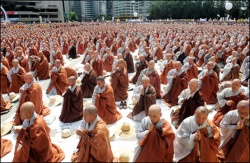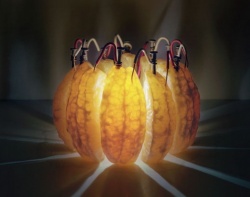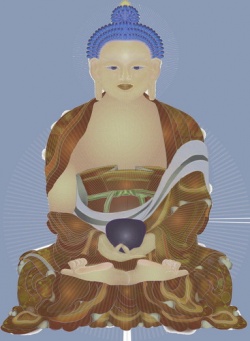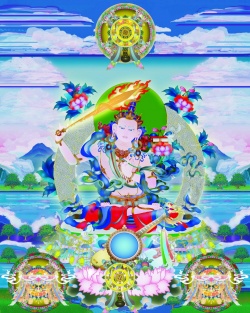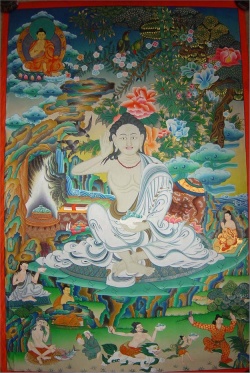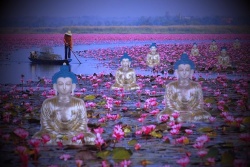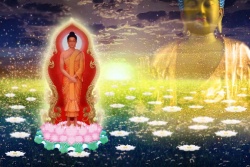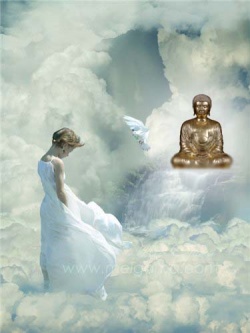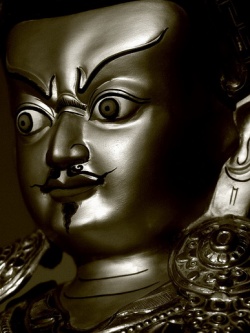Manual of Abhidharma - Additions Part 1
Class One: Abhidharma Overview
Abhidharma was one of the first forms of Buddhism to come to India. It is considered to be part of Hinayana, mainly of the Vaibhashika (Detailist) school. The main book for study of Abhidharma is Abhidharmakosha (Tib.: Chu Ngunpa Dzu) by Master Vasubandhu (Tib.: Loppon Yiknyen).
Tibetan: NGUNPA CHU DZU; ngunpa chu dzu
English: up to /approaching existing thing* treasury
- The highest existing thing in the Hinayana system is nirvana, so this refers to approaching nirvana.
Abhidharma means “up to nirvana.” It refers to what takes you up to nirvana, i.e. wisdom or understanding emptiness. So Abhidharma means wisdom/emptiness.
There were seven original great books of Abhidharma composed by the original followers of Buddha. Master Vasubandhu took all of those seven treasures and compiled them into the Abhidharmakosha.
The commentary we are using is TARLAM SELJE; tarlam selje, Illumination of the Path to Freedom, by the first Dalai Lama, Gyalwa Gendun Drup (1391-1474).
Why study emptiness? By being in deep meditation, you can’t do any non-virtue of speech or body (and perhaps mind, depending on how deep your meditation is). You can trick yourself into doing good deeds, but the only thing that will really cause you to only do good deeds is seeing emptiness (says Shantideva).
In this school, you are not in Abhidharma until you see emptiness directly. The accessories are your body, heaps (skandas), etc. and concentration, which allow you to experience emptiness.
Two types of Abhidharma – unstained knowledge:
1.) SHERAB; sherab higher knowledge (synonym for wisdom)
Main Abhidharma - consists of the three unstained or higher paths (of the five paths): seeing, habituation, and no-more-learning.
2.) JEDRANG; jedrang ;things following behind; “hanging”
Accessories to knowledge - wisdom from life, learning, contemplation, meditation, books.
a.) Nominal accessories: wisdom you were born with, books, hearing, contemplation, meditation.
b.) Real accessories: concentration and the heaps using during concentration.
Eight chapters in the Abhidharmakosha (root text):
1.) Categories of Existence - General concept and overview: The basic categories are stained or unstained. Stained means having to do with your bad thoughts, produced by them, producing them, or the bad deeds themselves. All existing things are either stained or unstained. Most of what we experience is stained.
2.) The powers - The faculties of perception (the senses); how do all things occur, how are they caused. Mental functions. This chapter is an elaboration of chapter one, where the powers are mentioned.
3.) The Suffering World - Description of all the realms: who is suffering and where they are suffering. Describes beings, time, space, planet formations, etc. This chapter elaborates on the suffering world mentioned in the first two chapters.
4.) Karma - This describes where the suffering world comes from and proves that the world is from karma and not from a creator God.
5.) Mental Afflictions (bad thoughts) – Describes how bad thoughts motivate karma.
6.) Person and Path - Person refers to advanced practitioners and path refers to wisdom.
How to escape suffering.
7.) Wisdom - More detail of wisdom mentioned in chapter six. Describes many kinds and details of wisdom.
8.) Balanced Meditation - Description of a Buddha’s knowledge, balanced between agitated and dull mind; a bright, attentive mind.
Four Requirements of a Buddhist Book:
1.) JUJA; juja- Subject matter is meaningful (The subject matter of the Abhidharma is the wisdom that understands stained and unstained objects).
2.) GUPA; gupa - Purpose (The purpose of the Abhidharma is to plant the seeds of wisdom.)
3.) NYI-GU; nyi-gui - Ultimate goal (The ultimate goal of Abhidharma is nirvana)
4.) DRELWA; drelwa - Relationship between the prior three (To attain nirvana requires wisdom, which is developed by studying that book).
If it doesn’t have these four, it isn’t a Buddhist book.
Class Two: Basic Kinds of Karma
Opening line of the fourth chapter of the Abhidharmakosha:
LE – LE JIKTEN NA-TSOK KYE; le – le jikten na-tsok kye
karmic deeds from basis to be destroyed various they come (i.e., the world)
Karmic deeds cause the multitude of worlds. All the planets and beings come from karma.
The following three categories are what people believe cause the world:
Unchanging things:
1.) GYU TAKPA; gyu takpa; Original cause, unchanging cause; like matter forming cause unchanging from the big bang.
2.) TSOWO; tsowo; main, primal energy The force, the primal energy which made things.
Changing things:
3.) WANGCHUK; wangchuk; A creator being.
main, principle, primal energy
In the opening of the fourth chapter of Abhidharmakosha, Vasubandhu asserts that the above three aren’t the source of existence using the reasoning's taught in our last (logic) class. He goes on to explain what is the source of existance:
DE – NI SEM – PA DANG DE – JE SEMPA YIKYI LE YIN-NO; de – ni sem – pa dang de – je sempa yikyi le yin-no;
movement of the mind and what it does/motivates karma of the mind is Karma is the movement of the mind (mental karma) and what follows (includes
The most basic division of karma is into two: motivating karma and motivated karma.
Motivating karma is the thoughts you have. Motivated karma is what you speak or do
after thinking about it.
The three kinds of karma: of body, speech, and mind (emotions are of mind and mental factors).
Two kinds of verbal and physical karma: (This idea is from the Detailist school only.)
Communicating the intention through the color, shape,
NAMPAR RIKJE form of the person. Ex. seeing someone with hands communicating clasped and understanding they are praying. Shape (color or form) which allows you to impute meaning.
NAMPAR RIKJE MAYINPA Non-communicating karma: when you do some very communicating it isn’t good or bad deed, you gain an invisible light-type aura which is from outside of you and permeating you.
Five qualities of non-communicating karma:
1.) Even when you aren’t thinking about it, it’s still there.
2.) Even when the mind is almost shut down (in very deep meditation) it’s still there.
3.) It has an ethical component – it’s either virtuous or non-virtuous.
4.) It continues on in a stream; it follows you through time and place.
5.) It is composed of subtle physical matter, having all types of elements (air, water,
fire, and earth) as its cause.
Your suffering is your world and you.
Each planet has its own hell realms, higher realms, etc. You must have a genuine, strong understanding of where the world came from. As long as even a small part of your mind believes the world came from a creator God, you won’t act based upon knowledge of karma, and can’t escape sufferings.
Class Three: Three Kinds of Karma, Four Kinds of Good Karma
Three kinds of karma:
DU RESHI LA NAMMIN YIDU ONGWA DEWA NGONGWA DANG
In the short term karmic result desirable, attractive happiness to experience and ripening
TENDU DUKNGYEL LE KYOPPA NYANGDE TOPJE GEWA
ultimately suffering from to protect nirvana it brings you good deed, virtue
A good deed (or virtue) is something which in the short term brings you a pleasurable experience, and which ultimately protects you from suffering by bringing you to nirvana.
NAMMIN YIDU MI-ONGWA MIDEWA NYONGWA NI MI-GEWA
karmic result undesirable unhappiness experience that bad deed
A bad deed (or non-virtue) is that which brings you a karmic result which is an undesirable, unpleasant experience.
YIDU ENG MI-ENG KYEPA DINYI LE SHENPAY LE LUNG MA TEN
desirable result undesirable result gives you these two other types karma neutral karma
Karma which is other than those two which give you desirable or undesirable results is neutral karma.
Four kinds of good karmic deeds:
1.) DUNDAM GEWA Nirvana: Only nominally karma – it’s not an ultimate good deed action.
2.) NGOWO NYIKYI GEWA Good deed by its very nature (there are five nature very by good deed of them):
Five deeds good by their very nature:
The three roots of virtue (the three kinds of mental functions):
1.) Non-desire - understanding the selflessness of things and so not desiring.
2.) Non-hatred - understanding selflessness and so not hating.
3.) Non-ignorance - wisdom.
Two thoughts of virtue always present when doing virtue:
4.) Avoid bad deeds for reasons relating to yourself (i.e. shame: ngo-tsa).
5.) Avoid bad deeds because someone else may find out (i.e. consideration: trel-yu).
3.) TSUNG-DEN When you have a virtuous thought, all of the linked association mental functions are virtuous by association. Those mental functions which are nominally neutral are colored by that thought.
4.) KUN-LONG Verbal and physical actions, stemming from motivation.
A metaphor for these four good deeds is that a healthy body is like nirvana.
The nature of spiritual education is to see the empty nature of things and then to have
the back and forth perceptions of things being empty vs. self-existant. Over time, we
see things’ self-existent nature less and less.
The ten non-virtues: (the most common of the 84,000 bad deeds)
Involving body:
1.) Killing
2.) Stealing
Involving speech:
4.) Lying (giving the wrong impression)
5.) Divisive speech (alienating others from each other)
6.) Harsh words
7.) Meaningless talk
Involving thoughts:
8.) Coveting
9.) Ill-will
10.) Wrong views (This is the worst of all. If we believed in karma, we wouldn’t do
the other nine.)
Class Four: Divisions of Karma and Karmic Results
There are many ways to divide karma and explain or classify it. A few are listed here:
Karmic consequences (by when you experience the result):
which you are going to see which will karma
Karma whose results you will see in this life. This is the basis of how tantra works.
after born experienced which will karma
Karma you experience in the very next life after this one (not counting the bardo, which is a birth as well).
3.) LEN-DRANG SHEN-LA NYONG – GYUR GYI LE
times other in experienced will be which will karma
Karma which you experience in any life after your next one.
Four kinds of karma which must ripen (the seeds will definitely ripen rather than remaining latent):
1.) SHUK DRAKPO Deed committed with strong emotion (Or even charged force fierce thought: -”I know I’m right” and acting on it is strong ignorance – a mental function, like emotion.)
2.) YONTEN GYI SHI Deed committed toward a very holy object (such as the good personal basis three jewels). Because the object has so much potential quality to help others, the impact of actions toward it affects many others, too.
3.) GYUN – CHAKSU Deed committed over and over again will produce a over and over again result. It becomes stronger and stronger.
4.) PA MA SUPA Killing your father or mother. Even if done with father mother killing motivation to benefit them, it will produce negative karma. This is among the worst things you can do.
Two things that will make karma ripen in this life:
1.) SHING GI KYEPAR Doing a deed toward a “distinctive” (powerful) object.
object distinctive A powerful object is one that can benefit many beings, or beings who have just come out of various high states.
2.) SAMPAY KYEPAR Deed done with an extraordinary motivation or thought.
thought distinctive The object or thought must be powerful enough to cause the karma to ripen in this life. Tantra is based upon this.
Three karmic results (from Je Tsongkapa’s Lam Rim Chenmo):
1.) NAM-MIN Ripening depends upon how strong your emotions (desire, ripening anger, etc.) are when you do the deed, what’s the motivation, and how bad was the deed. A big bad deed such as killing results in hells; medium killing results in craving spirits rebirth, lesser killing results in an animal rebirth. Lesser means by accident; greater means with premeditated hate.
2.) GYU – TUN With corresponding results, there is a similarity between what corresponding you did and what you get back. There are two kinds:
a.) NYONG-WA, or similar experience. Here the resulting experience is similar to the experience that caused it. For
example if you stole, you will never have enough. If you killed, you will have a short or sickly life.
b.) JE-PA, or similar habit. You will have a predisposition to do that thing again in a future life.
3.) DAK -DRE There is an environmental correspondence. For example, if you killed, you will live in a dangerous place with wars, muggers, etc. From sexual misconduct, you live in a place of stink, feces, filth, etc.
Examples of powerful objects which will cause karmic results to ripen in this life:
1.) Someone who has just come out of cessation meditation for the first time. Anything you do toward them at that moment becomes very powerful.
2.) Someone who just came out of immeasurable love or no-mind meditation for the first
time. They are very close to liberation.
3.) Someone who has just come out of seeing emptiness for the first time.
4.) Someone who just became an Arhant.
Class Five: How Karma is Carried
(This lecture is based on the Madhyamika Prasangika (Implication) school, from the text:
middle way real intent total clarification
The Total Illumination of the Real Intent of the Middle Way, by Je Tsongkapa (1357-1419),
which explains the SEM TSAMPA, or mind only presentation of how karma works, which is basically accepted by the Prasangika, and all other schools.
According to the Mind-Only school, this is how karma works:
You see an angry person yelling at you.
Eye consciousness (mikki namshe) allows you to see a person yelling at you. The eye faculty (mikki wangpo), the physical entity consisting of rods, cones, lens, etc., takes in the image and transmits it to the eye consciousness in your brain. You look at the person yelling, the eye faculty senses colors and shapes. Based upon that, a consciousness grows – you apprehend that the person is there with those colors, shapes, etc.
All your karmic seeds (bakchaks) are stored in your foundation or storehouse consciousness (kunshi). Then the seeds start to grow and create their result. It creates an eye consciousness (mikki namshe) - awareness of the yelling face. In fact, it’s looking at itself. Mind-only school has the idea of kunshi to explain where karmic seeds are stored.
Mind-only school says that the bakchak produces a mental event (eye-consciousness) that looks like your eye faculty. You interpret it to be your eye. It’s an emanation of kunshi, producing an image which you think is your eye faculty. The karmic seed causes an instance of kunshi which looks to you as an eye faculty, but is just a part of
consciousness, looking at itself.
The kunshi is the place where the bakchaks stay, and it’s what starts to look to you like your eye. It’s all consciousness. There are no outer forms at all. Any time you see anything outside, it’s just you seeing your own mind looking like that. The eye is a display of the mind’s (kunshi’s) bakchaks, and there isn’t any eye at all. Consciousness is seeing consciousness; it’s you seeing your mind. There is only mind – no outer forms.
(This example applies to eye consciousness and eye faculty. It also applies to all of the other senses in the same way – ear, taste, smell, touch.)
In the mind-only school, emptiness means that the same karmic seed ripening in your foundation consciousness creates or causes all these things: the mind that sees the angry person, the eye that senses the angry person, and the angry person himself. There is no separate seed or substance for the perceiver and the object perceived.
Collective karma means that everyone who gets together and does a deed (such as having classes) will all enjoy some event in the future together. Everyone in New York has the same karma to enjoy the same results. Someone who died or moved lost the karma to enjoy that result in New York.
The seer and what he sees is created by a karmic seed. The seer is your awareness/ consciousness. What he sees is the eye (foundation), and by extension, the yelling man. You are seeing your mind yelling at you. Your experience of the whole universe is you experiencing your mind.
That’s how you get enlightened. You plant all the right bakchaks in the kunshi and then you see yourself as an immortal deity in a paradise as a result. You must put the correct bakchaks in the kunshi to become enlightened. Just imagining yourself as a deity won’t work to reprogram your consciousness because your actions aren’t creating the right
bakchaks in the kunshi. All bakchaks must be the kind to yield yourself as a deity; not just your thoughts, but speech and deeds as well. This is why morality is the basis of enlightenment.
Once the existing bakchaks ripen, it’s too late to imagine things are pleasurable. Getting yelled at is no fun no matter how much you imagine it is pleasant. You can have a good attitude about an unpleasant object, which will plant the pleasurable future seed. It’s too late to change the seed that’s ripening.
How a karmic seed is planted
You yell at someone. As that deed comes to its conclusion, in the next instant, the remaining energy of the deed is transferred to the kunshi in the form of a bakchak. A bakchak is not mental and not physical. It’s a kind of energy, or energetic potential, that stays in your mind. How does it stay around and remain preserved over time? It is a changing thing, each instant changing and continuing. The thing that affects the nature of how it changes and fluctuates as it streams on is your motivation, the object, confession, etc. as we listed earlier. If you yell at someone, it produces the result of you being yelled at later. Is it a person yelling at you later?
No, how could mind create a person? Mind creates mind. The awareness of yourself yelling creates an awareness of yourself being yelled at. Nasty content going in results in nasty content coming out. In Madhyamika Prasangika you perceive yourself doing a deed – say a virtue – and that perception plants a bakchak. That bakchak flowers into a result. That’s why your motivation is the most important component of a karma (after a powerful object). Your perception of what you did (helped, hurt, etc.) mostly forms the bakchak, although there is another contributor to the bakchak’s formation – the deed itself.
The bakchaks reside in your stream of mind/being – in the unexamined “me” – what I call myself, the simple me, as I normally conceive of myself.
When the Buddha spoke of the world being “mind-only, created by your own mind”, he meant (1) the worlds are created by karma and not a creator God. And (2) he wanted you to know that your mind is the main thing; the world is mainly coming from your own mind’s ignorance.
TOK – PE TAK – TSAM The world is just what you label it.
by your own conceptions just labelled
They say that there are parts out there that appear to you in a certain way. You perceive them and label them in a certain way as angry, happy, etc. When you look for the parts out there, you find parts of parts, ad infinitum, without end. That’s a meditation on emptiness. If you continue to look for the most basic parts that you label “parts that are really there that I’m not labelling”, you’ll never find them. That’s it’s emptiness.
See also
- Manual of Abhidharma - Reading One: Introduction to Abhidharma
- Manual of Abhidharma - Reading Two: The Nature of Karma, and What it Produces; the Detailist Concept of ''Non-Communicating Form''
- Manual of Abhidharma - Reading Three: Types of Deeds, and the Nature of Motivation
- Manual of Abhidharma - Reading Four: The Correlation of Deeds and Their Results
- Manual of Abhidharma - Reading Five: How Karma is Carried, According to the Mind- Only School
- Manual of Abhidharma - Reading Six: How Emptiness Allows Karma to Work, According to the Middle-Way School
- Manual of Abhidharma - Reading Seven: Black and White Deeds, the “Path of Action,” and the Root and Branch Non-Virtues
- Manual of Abhidharma - Reading Eight: Most Basic Virtue, and the Projecting and Finishing Energy of Deeds
- Manual of Abhidharma - Reading Nine: The Five Immediate Misdeeds, and the Concept of a Schism
- Manual of Abhidharma - Reading Ten: The Relative Severity of Deeds and What Causes It
- Manual of Abhidharma - Additions Part 1
- Manual of Abhidharma - Additions Part 2
